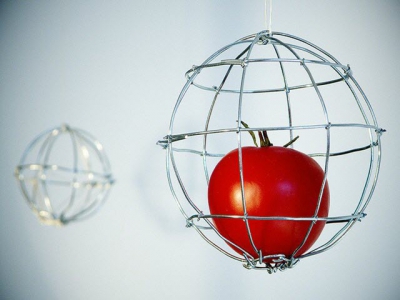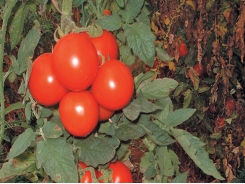6 Ways to Build Your Own Tomato Cages

Although a near-necessity for growing tomatoes, tomato cages can be as fancy, homemade, or as economical as you’d like. If you have some spare materials, you can avoid making a trip to the store prior to making your own tomato cages. Then again, if you are looking to upgrade your typical cages to ones that may outlast even you, you’ll need to part ways with a chunk of your wallet. Either way, we present a variety of DIY tomato cages for the thrifty and spendthrift alike. Share your own DIY cages!
BAMBOO CAGES
If your property is lucky (or unfortunate, depending on how you view it) enough to have fast-growing bamboo, you have a free and endless supply of tomato cage framing material. Creating tomato cages from bamboo requires very little time and effort. First, make 4 holes in the soil about 8 inches deep. Next, insert a 40-inch-tall bamboo shoot into each hole. You now have the frame of your cage.
You’ll want to tie climbing support posts (made of shorter bamboo pieces) two or three levels high, depending on the variety and heartiness of tomato plant. To attach bamboo to bamboo, use yarn, fish line, or twine. Your bamboo cage may last years, but expect the decomposition where bamboo touches soil and, potentially, the tie material you use. For longer lasting cages, use plastic around the bamboo posts that sit in soil and use an inorganic tie such as fish line.
PVC CAGES
This method will take more planning, effort, time, and dollars. However, PVC cages will provide lasting sturdiness for growing tomato plants. The concept is simple: connect lots of PVC pipes together using elbows, ensuring the cage itself is secure to the ground.
Application is a bit more difficult. First, you’ll have to visualize or draw out, the design in your head. How tall will they be? How many runs will appear along the way? The next step is a trip to the store to get enough PVC piping to create as many tomato cages as desired. The trickier part will be determining how many elbows you’ll need per cage. If it’s easier, cut your PVC first, do a mock assembly and tally the needed elbows as you “build.”
ALL WOOD
If you have extra lumber sitting around, you can potentially whip up several all-wood tomato plant cages. These strong and sturdy cages are excellent keepers for strong tomato plants that might otherwise bend wire cages or, worse, squish their soft fruits into oblivion.
You’ll need four long, strong stakes to insert into the soil. Dig holes for each of these posts. The stakes can be as high as you prefer. From there comes the easy task of nailing side support beams at various intervals to the height of the stakes. Once assembled, simply insert into your ground holes and secure with soil. The type of wood you use will determine the strength and lifespan of your cage. You might want to avoid softwoods such as cedar, fir, pine, redwood, or spruce.
METAL PIPES
This design calls for plastic tubes, but having already provided a PVC option, we think a metal structure would be a fantastic alternative. Like the PVC method, this cage will require some foresight but will moreso require power tools.
Pick up three metal pipes from your local hardware store. They may need to be cut to the desired height. These pipes will form the stakes and should be 1-2 inches wide. Smaller pipes will also be necessary to form the cross-support beams; these pipes should be about ½ an inch wide. Drill holes in the stakes that allow you to slide the smaller beams through, cross-wise. Once you dig your holes, insert the stakes and support beams.
If you’re especially handy, you might even be able to hook up an irrigation system to the pipes.
THE STAKE-A-CAGE
If you lack bamboo or excess lumber, here is a method for making wire tomato supports. You’ll particularly like this method if you prefer wire cages or have a large quantity of tomato plants growing. This method is not a cage, per se, but more of a flat support panel. Although this DIYer claims the cage only costs $2, this is only true if you have chicken coop or other wire mesh readily available to repurpose. If you don’t, you will need to buy a roll, and this can be quite costly.
Once you have secured your wire supply, cut into rectangular grids of desired size. Nail one grid to a centralized wood stake: this could be a fallen branch or discarded lumber. The bottom portion of the stake must remain uncovered for you to insert the stake securely into the ground. Make sure your grid doesn’t extend much higher than your stake or you may experience grid bowing.
THE TOMATO-LOVER’S TRELLIS
You have to really love tomatoes (or other vine produce) to try this DIY method. While not overly difficult, this method is semi-permanent; while it can be disassembled, it won’t come down without some force and destruction. Be sure you have picked the perfect spot for your tomatoes before attempting to build.
This beautiful 16-foot long structure features 12-inch raised-bed edges and 8-foot support beams (two feet are in the ground). Over the top are multi-use curved PVC pipes: you can choose to install an irrigation system or you can use the hoops to drape plastic, as this DIYer has. By the time the builder is done, the structure is surrounded by roll-up netting and draped plastic. His tomatoes will grow at least six feet tall, which is why he installed clothesline-type vine support at the top of the structure.
Có thể bạn quan tâm
Phần mềm

Phối trộn thức ăn chăn nuôi

Pha dung dịch thủy canh

Định mức cho tôm ăn

Phối trộn phân bón NPK

Xác định tỷ lệ tôm sống

Chuyển đổi đơn vị phân bón

Xác định công suất sục khí

Chuyển đổi đơn vị tôm

Tính diện tích nhà kính

Tính thể tích ao hồ



 7 Tips for a High-Yield Vegetable Garden, Even…
7 Tips for a High-Yield Vegetable Garden, Even…  How tomato growers can practice IPM
How tomato growers can practice IPM